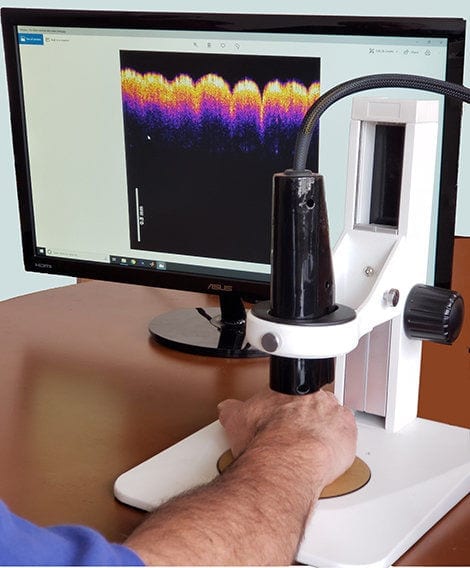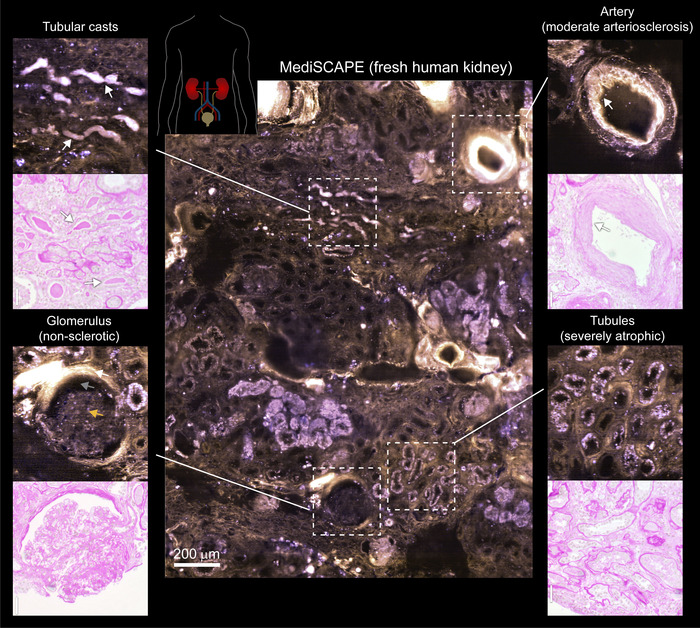
Rutgers University
Using sound vibrations and pulses of near-infrared light, a Rutgers University scientist has developed a new “virtual biopsy” device that can quickly determine a skin lesion’s depth and potential malignancy without using a scalpel.
The ability to analyze a skin tumor non-invasively could make biopsies much less risky and distressing to patients, according to a report in Wiley Online Library. Currently, physicians who perform surgical biopsies often don’t know the extent of a lesion – and whether it will be necessary to refer the patient to a specialist for extensive tissue removal or plastic surgery – until surgery has already begun.
The first-of-its-kind experimental procedure, called vibrational optical coherence tomography (VOCT), creates a 3-D map of the legion’s width and depth under the skin with a tiny laser diode. It also uses soundwaves to test the lesion’s density and stiffness since cancer cells are stiffer than healthy cells. An inch-long speaker applies audible soundwaves against the skin to measure the skin’s vibrations and determine whether the lesion is malignant.
“This procedure can be completed in 15 minutes with no discomfort to the patient, who feels no sensation from the light or the nearly inaudible sound. It’s a significant improvement over surgical biopsies, which are invasive, expensive and time consuming,” said lead researcher Frederick Silver, a professor of pathology and laboratory medicine at Rutgers Robert Wood Johnson Medical School.
The study found that a prototype VOCT device, which awaits FDA approval for large-scale testing, is able to accurately distinguish between healthy skin and different types of skin lesions and carcinomas. The researchers tested the device over six months on four skin excisions and on eight volunteers without skin lesions. Further studies are needed to fine-tune the device’s ability to identify a lesion’s borders and areas of greatest density and stiffness, which would allow physicians to remove tumors with minimally invasive surgery.
Learn more: Rutgers Scientist Creates “Virtual Biopsy” Device to Detect Skin Tumors
The Latest on: Non-invasive biopsy
[google_news title=”” keyword=”non-invasive biopsy” num_posts=”10″ blurb_length=”0″ show_thumb=”left”]
via Google News
The Latest on: Non-invasive biopsy
- Owlstone secures $6.5M for breath-based diagnostics for infectious diseaseon April 26, 2024 at 5:40 am
Owlstone Medical has secured a $5 million equity investment and initial $1.5 million grant funding, committed by the Bill and Melinda Gates Foundation, for development of breath-based diagnostic ...
- Sophia Genetics Announces Syndicate Bio As First Liquid Biopsy Customer In Africaon April 26, 2024 at 1:03 am
Boston, MA and Rolle, Switzerland, April 23, 2024 ndash; SOPHiA GENETICS (Nasdaq: SOPH), a cloud-native software company in the healthcare space and a leader i ...
- Smart Biopsy Devices Market Sizing Up Success Unlocking New Avenues in the Market of Tomorrowon April 25, 2024 at 9:46 pm
Smart Biopsy Devices Market is valued at approximately USD 2.5 billion in 2019 and is anticipated to grow with a healthy growth rate of more than 5.7% over the forecast period 2020-2027. Biopsy is a ...
- Strong Future Outlook for OncoCyte: Buy Rating and Increased Price Target Amid Positive Partnerships and Financial Efficiencyon April 24, 2024 at 7:45 am
OncoCyte (OCX – Research Report), the Healthcare sector company, was revisited by a Wall Street analyst today. Analyst Michael Matson ...
- Urine-based test detects head and neck canceron April 23, 2024 at 4:15 am
While the initial study focused on head and neck cancer, the team also analyzed urine samples of people with other cancers, such as breast and acute myeloid leukemia, and found that ultrashort ...
- FDA Approves Nogapendekin Alfa Inbakicept for BCG-Unresponsive NMIBC Carcinoma In Situon April 22, 2024 at 3:23 pm
Patients with Bacillus Calmette-Guérin-unresponsive non-muscle-invasive bladder cancer carcinoma in situ now have a new treatment option following the FDA’s approval of N-803.
- Medicare ignored expert advice to cut tests for transplant patientson April 19, 2024 at 2:55 pm
Contractors for the Centers for Medicare and Medicaid Services (CMS) cut access to tests for transplant patients that could show early signs of organ rejection despite expert physicians advising the ...
- Testing urine for prostate cancer - the crystal ball in your bladderon April 19, 2024 at 5:35 am
Have you ever felt like you're just waiting for the other shoe to drop, especially regarding medical test results? Francis Collins, former NIH director, found himself in that situation, dancing the ...
- Biopsy Devices Market Analysis, Size, Global Forecast Report 2024-2030 - Increased Demand for Minimally Invasive Diagnostic Techniqueson April 19, 2024 at 1:10 am
The "Biopsy Devices Market, Size, Global Forecast 2024-2030, Industry Trends, Share, Growth, Insight, Impact of Inflation, Top Companies Analysis" report has been added to ResearchAndMarkets.com's ...
- Non-Invasive Liquid Biopsy Market CAGR of 15.7%, Size, Trends, Growth Status, Share, Research, and Forecast 2024 to 2032on April 16, 2024 at 2:06 pm
Liquid biopsy has emerged as a promising non-invasive technique for detecting and monitoring various types of cancers. Unlike traditional tissue biopsies, which often involve invasive procedures, ...
via Bing News










